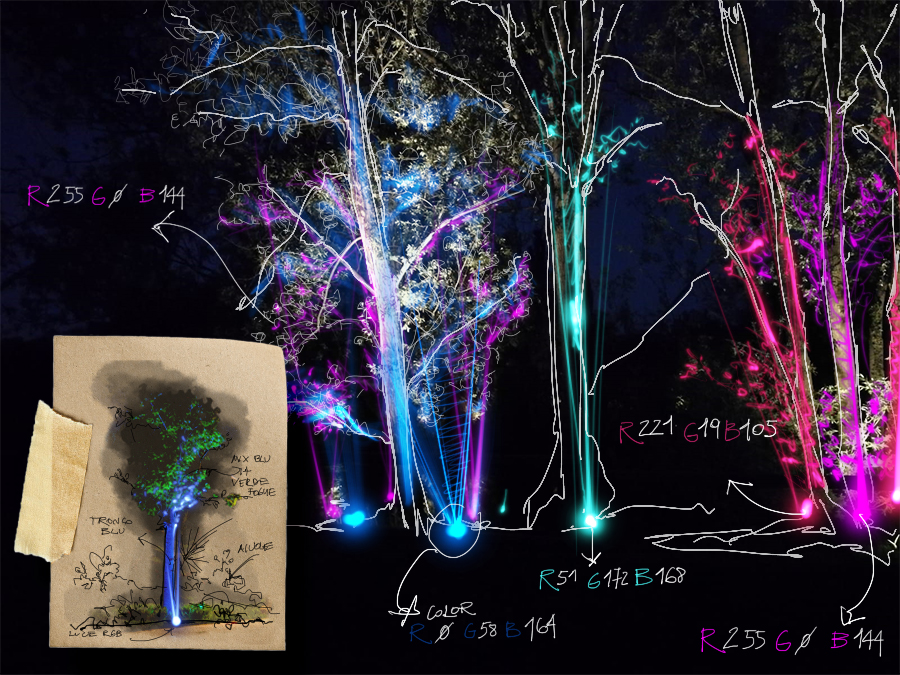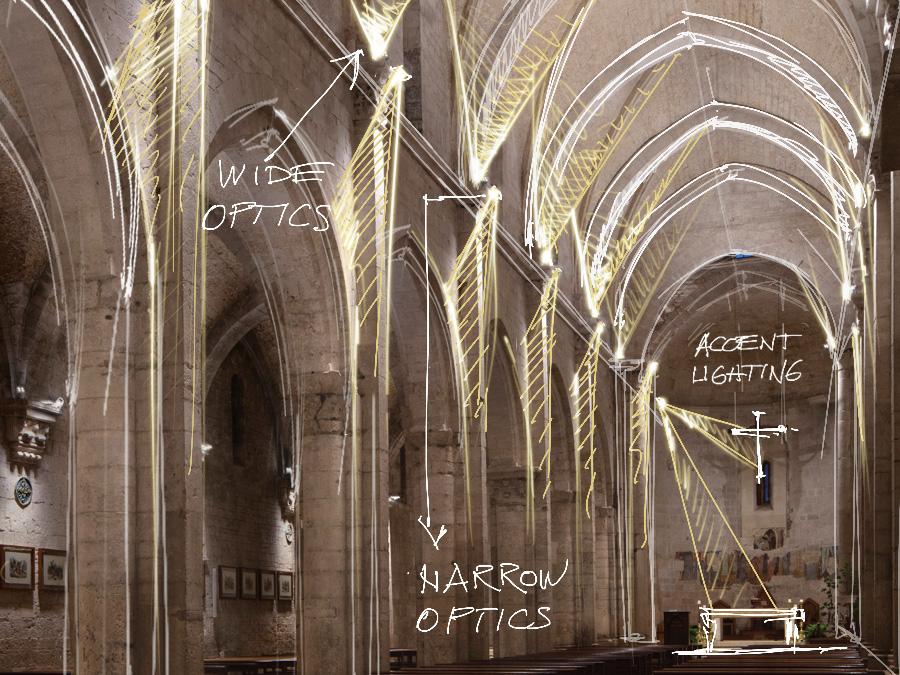In this third step, we concentrate first on the variable of colour: the colour of the finishes on lighting fixtures for landscape lighting, and which colour of light is best suited to foliage – cool white, warm white or coloured? Then we move on to light pollution reduction and light modulation using control systems. We conclude with a short overview of the protection systems we build into our products used in gardens.
The finish that stays out of the limelight
In the landscape of garden lighting fixtures, we believe that products can be divided into two camps: fixtures with a distinctive design that draw attention to themselves and fixtures with a minimal design that aim to blend into their surroundings.
Needless to say, we belong in the second camp: our philosophy is to put light firmly centre stage as the sole protagonist.
We have therefore placed the ability to blend in at the centre of our philosophy and given designers the option to request the fixture body be painted in a specific (RAL) colour

Applied to gardens, this means designers can choose the shade of green that best matches the vegetation in which the fixture will be inserted.
Additionally, on a selection of outdoor projectors, we offer the jasper green finish as standard, which is a green with the cool mineral tones of stone and woodland vegetation.

Pivot 1.7 Find out more about the product 
Ginko 2.0, jasper green Find out more about the product 
Ginko 1.0, jasper green Find out more about the product
No need for nerves of steel with a steel cable
In the previous post, we saw that projectors are often installed near shrubs or low plants, and now we’re talking about green finishes that will help them blend in. But what happens if the projector blends into the grass between the shrubs so well that our gardener gets too close to the cable with his lawnmower and … “zap!” 😱
Because that’s exactly what would happen: “zap”.
We put ourselves in that gardener’s shoes (or in those of that unobservant family member) and decided to protect the cable with a flexible steel cable-protection tube that encases the most exposed part, the bit near the lighting fixture where the cable usually makes a final bend and “za...” Not any more, though: now there’s a protective sheath on it, everyone is safely home and dry ;)
On the subject of cables, one piece of advice we would like to give you is to make sure that the fixture you’ve chosen has a long enough cable to reach the cable pits, to avoid the need for a junction box.
💡 📞 💡
Our fixtures for outdoor applications are available with standard cable lengths of up to 20 m.
Do you need a longer length? Please request it when ordering: we’ll supply it even if it is not listed in the catalogue.
What is the recommended colour temperature for lighting greenery?
We asked our social media community what they would choose to light greenery: cool light or warm light? The match was won by warm light with 56% of the votes, a sign that there’s plenty of room for discussion.
What’s interesting is that, when justifying their answer, both sides offered the same reason: to achieve a “natural” light.
And that is the crux of the matter! What light are we aiming for?
The intimate, warm light of sunshine ... at night?
Or the cool light of a full moon?
Next time we’ll ask people what they mean by natural light :)
Anyone who has tried adding these colours, as if they were tubes of paint, knows that the result is not necessarily what we're looking for in a garden.
The “warm green” evokes images of drought that we may not want to recall when looking at a garden.

On the other hand, in the “cool green” example, the leaf looks brighter, and the bluish reflections call to mind the effects of dew and rain, and the dampness of the woods. We probably feel this is closer to the idea of nature that we hold in our mind’s eye.

Warm green, 2700K

Cool green, 4000K
However, everything changes depending on the type of plant and grass, and we are on very subjective ground. It may well be that some plants with orange veins or red leaves, such as maple trees, are better served with warm light.
Precisely because these are subjective decisions, people side with one or other of the following views :) ⚖️
👉🏽 Both plant types probably coexist in our gardens, and therefore it would be a good idea to use the right colour temperature for the type of plant.
👉🏽 We don’t want different colour temperatures creating a confusing scene, and therefore it would be a good idea to maintain the same colour temperature throughout the garden.
where there are big differences in the shades of green, we’ll work with different colour temperatures, “detaching” the planes of perception from each other;
where the differences between the greens are not as marked, we’ll try to smooth things out by using the same colour temperature.
The situation with the French regulations1
On 1 January 2020, regulations came into force in France that control the use of external lighting and in particular the colour temperature, with an aim to preventing or reducing light pollution.
🔶 For instance, in places where astronomical observatories are located, a warm white ≤ 3000K is required;
🔶 In parks visited by people, it’s 2700K, while parkland with no visitors, and nature reserves are lit with the more amber tones of 2400K.

Neva 6.0, dynamic white, 20W, 24°x46° Find out more about the product
💡 📞 💡
We have fulfilled many requests for fixtures with an amber colour temperature. Even if you don’t see the code listed as standard, put in a special request. Every request is an order :)
Is RGB or coloured light suitable for a garden?
Let’s say that it is suitable in certain contexts, such as in the grounds of reception rooms or a piece of installation art. The use of coloured light in nature often has a shock effect that needs to be appropriate to the context.

Spot 3.0 316L, RGB, 18W, 10° Go to the project and credits

Bright 2.4, RGB, 5W, 20° Go to the project and credits
Mind you, if you need to go big for a particular event, we're the first to enjoy the opportunity and, in fact, we suggest you double up the effect by experimenting with two different colours if the plants lend themselves to that.
Here, for instance, we played around with an olive tree, lighting the front with a fuchsia light and the part to the rear of the trunk with an aqua-green light. The effect of the coloured reflections mixing on the silvery leaves as they danced in the wind was breathtaking 🤩

Litus 5.6, RGB, 7W, 45° Find out more about the product

What is light pollution and how can you reduce it in the garden?
Light pollution is “the alteration of the natural quantity of light in the night environment due to the introduction of artificial light”. Artificial light pollutes when it alters the amount of natural light present.2

Clearly, we are not going to tell you to turn the lights off; instead, we want to analyse the correct behaviour to adopt to avoid light spill.
We are well aware what a fundamental role light plays in enhancing architecture, and we believe that it is possible to find the right balance between light and dark while using light responsibly.
Over the years we have supported the spread of a light culture aimed at preventing light pollution, and we have developed various solutions to effectively combat this phenomenon.

“The urgent need for greater respect for the environment, coupled with the need for energy conservation and more consideration for people’s mental and physical wellbeing, is guiding us towards a new way of working on architectural design, shifting the focus back to the location’s context and cultural spirit, and refining people's sensitivity to the quality of the light.”
Architect Giovanni Traverso, Modelling Daylight, a manual for natural light experimentation
On a practical note, in gardens we recommend directing the luminous flux very precisely to ensure it remains within the surface to be lit, and avoid it spreading beyond.
Sometimes it is enough to choose a tiltable recessed fixture over one with fixed optics, or a projector over a recessed fixture.
Sometimes the use of grazing light along the walls or the ground helps to reduce dispersion.
At other times, however, these measures are not enough, and you must take into account the performance of the fixture itself, as in the case of garden bollards.
A bollard’s reliability resides, above all, in the quality of its optics, which direct the luminous flux where needed, minimising or even eliminating upward dispersion and uncontrolled reflections.
A high-power recessed fixture installed in the lawn and pointing directly at the sky ... can definitely be put to better use elsewhere :)

Following on from the choice of lighting fixture and its positioning comes the no less important consideration of control systems, which brings us to the next point.
The use of light: different lighting for different times
The customisation of fixtures’ switch-on times, based on the hours the spaces are in use, enables us to save on energy consumption first of all – and helps us to plan for light not only where it is needed but also when it is needed.
Control systems allow us to set up scenic lighting in a residential garden during the evening hours and ensure minimum safety lighting through the night.
In the case of reception venue grounds, the use of different lighting scenarios in summer and winter means different features of the plants and trees can be highlighted according to the season.
Adaptive light follows the same principle. Without straying too far into the realm of urban lighting, think of the garden bollards that light a path only when movement is detected by a sensor.
Here is a project that works with different switch-on times: Cascina Ranverso

Neva 1, 2700K, 9W / 27W / 45W, 10°x40°, with honeycomb louvre, customized version CRI 90 - Bright 3.G, 2700K, 9W , 35° Go to the project and credits
Nocturnal animals
We feel duty bound to refer briefly to recent studies carried out on the effects of artificial light on animals. Reducing lighting at night reduces the disorienting impact it has on the migratory flows of certain species of birds that travel at night.

A prime example of the effect on nocturnal animals is that of bats. They are sensitive to the presence of light at night, which can lead them to abandon some areas completely. in parks and gardens frequented by humans, bats are often sought as a “natural remedy” against mosquitoes, and it would be counterproductive to prepare bat boxes to encourage bats without also installing a control system for night-time lighting.
Protection systems
We end our walk with a quick overview of the protection systems that guarantee the survival of lighting fixtures in this “savage forest” :)
Click to explore the protection systems built into our fixtures
This brings us to the end of our excursion around the illuminated garden, moving from tree foliage to trunks, low plants and shadows, and finishing with coloured light and the subjects of usage and protection. Do let us know if there are any other topics you would like us to explore in more detail in the future!
Have you lit a green space with our fixtures? What are you waiting for …
If, on the other hand, you want our help with designing a garden, or you have any queries you'd like to put to us











